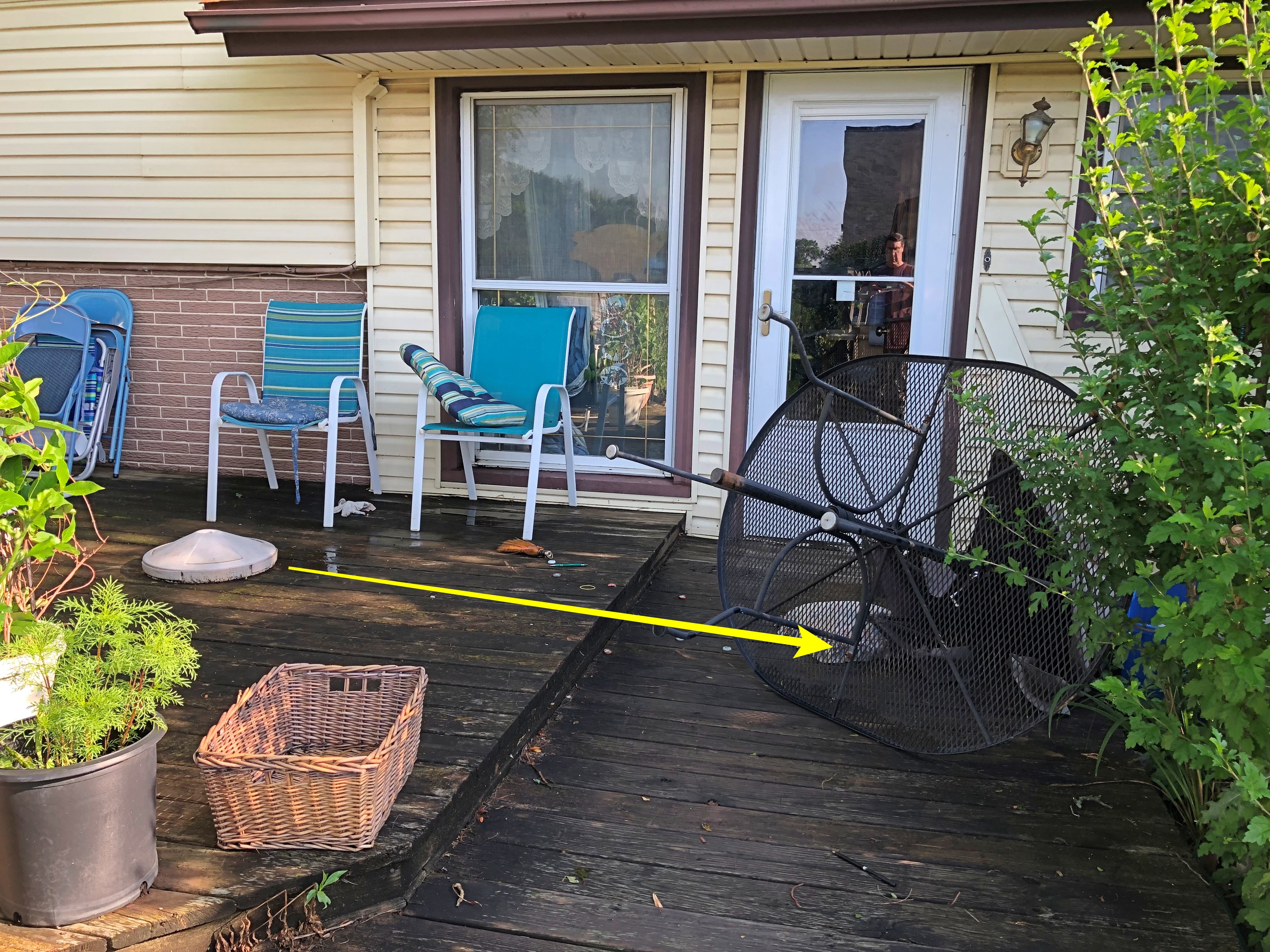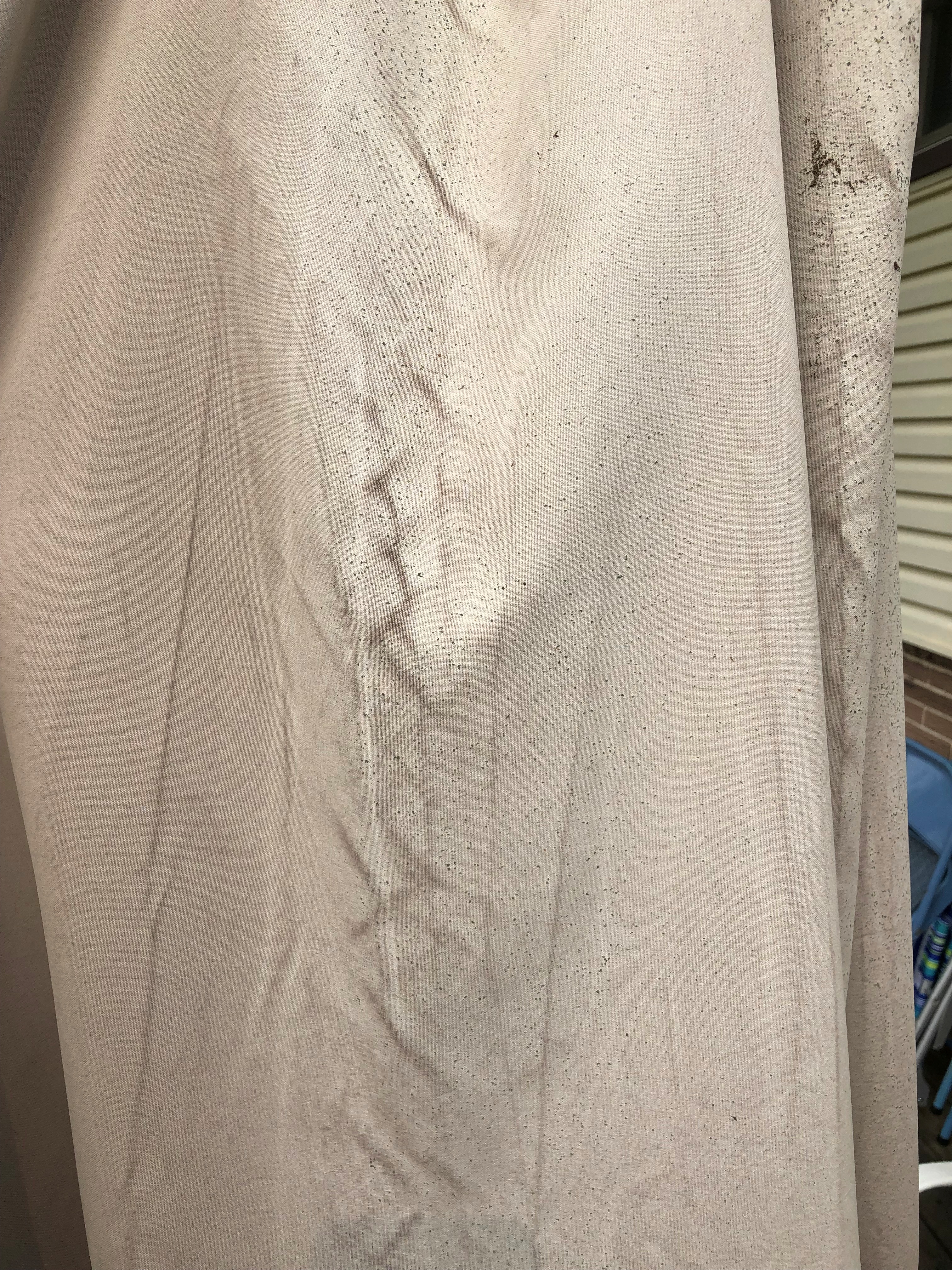On Friday, we walked the dog just ahead of sunset. It had been an overcast day, warm and humid, but not too bad. The clouds didn’t look particularly threatening at that moment, either for rain or wind or a possible thunderstorm.
After we returned, I went out to our deck to enjoy the twilight and to read a book I’d just started, A Need to Testify by Iris Origo (1984), which is composed of biographical sketches of four brave anti-fascists – you’d have to be brave – in Fascist Italy. It seemed like a good thing to read after I’d re-read Homage to Catalonia, which seemed like a good thing to re-read after many years, and after visiting Catalonia.
The deck has a broad view off to the south. As dusk settled in on Friday, I noticed cloud-to-cloud lightning far off to the southwest. Blue and white lighting up the gray clouds. So far away that I heard no thunder, and not close enough for me to head inside. Not yet, anyway. Still, it’s good to take lightning seriously. Drops of rain started to fall, but not many. Enough to splash the book. I parked myself under the house’s awning and kept reading in that dry spot. My glasses, which I’d left on cast-iron table on the deck, started collecting droplets.
For 10 or 15 minutes, it got darker but the rain got no heavier. There wasn’t much wind, if any. I looked up from my book and noticed the lightning to the southwest was now a lot closer. Time to go inside, I thought, and I collected my glasses and my book and pretty soon I’d settled on the couch in the living room to carry on reading. Soon I heard heavy rain but still not much wind, and scattered thunder off in the distance.
The rain grew heavier and the thunder grew louder and then BOOM! That meant close by lightning. Very close. BOOM! BOOM! Somewhere in the neighborhood, I figured. Not unusual at all. Happens a few times a year. The rain continued and I continued reading. Our power was still on and I hadn’t heard anything hit the roof, so I wasn’t worried. Before long, in no more than a half hour, the thunder and rain had slacked off.
Late that evening, when all was quiet outside, Ann let the dog out into the back yard, and then came to me and said, “You should look outside. The table’s knocked over.”
What? Really?
There it was – our cast-iron table, flipped nearly upside down, about eight or nine feet from where it usually is (I measured later) and four feet from the door but not blocking it, with the deck umbrella thrust toward the ground near where we keep our blue recycle bin.
Wind did that? I wondered. What wind? I didn’t hear any wind during the storm. How was it I didn’t hear the table crashing to the other side of the deck?
Considering that it was dark, and still wet on the deck, and the hour was latish – about 11 by this time – I left the task of moving the table back until the morning. Also, I wanted to take a few pictures.
The table is on the right, of course. To the left is a heavy base in which we put the umbrella pole. So the table and umbrella flew in tandem from that point to where they came to rest, leaving the base behind.
If not for the deck umbrella, I think the table would have gone further, and maybe flipped all the way over. In any case, the table, which is cast-iron and weighs maybe 100 pounds, has never been moved by wind from its spot on the deck in the 20 years we’ve lived here, though occasionally the umbrella has been lifted away, and sometimes ahead of wind I move the table to be flush with the house’s wall. I know that the table could fly, of course, in the event of a tornado, say. Or maybe a focused micro-burst? A really focused micro-burst?
I checked for other damage in the area. Luckily, I found none. The deck was OK (though it’s old). The roof looked OK, which was a relief, since it isn’t that old. The back yard fences were still standing, as they have in much worse wind after I re-enforced them this spring. There weren’t even any branches on the ground in either the back or front yards.
How precise was that micro-burst anyway? And could it properly be called a micro-burst? A nano-burst maybe?
For a few minutes, that took me on a digression. I knew that pico-, femto- and atto- are smaller than nano-, in that order getting smaller, so I wondered about the whimsical coinage of pico-burst or femto-burst or atto-burst. How much force would those smaller winds involve? Not much, I imagine. A femto-burst might be what, a fart?
I looked up the metric prefixes and found out that recently – last year – the General Conference on Weights and Measures (Conférence générale des poids et mesures, CGPM), which defines measurement standards internationally, added four more prefixes to the SI.
Two smaller: ronto and quecto, 10 to the minus 27th power and 10 to the minus 30th, respectively. Two larger: ronna and quetta, 10 to the 27th power and 10 to the 30th, respectively.
Just for reference: 10 to the 30th power is
1,000,000,000,000,000,000,000,000,000,000.
Just for grins, because who could use a number that large or that small? Scientists and engineers, apparently, which makes me marvel that the frontiers of science and engineering involve measurements of that inconceivable kind.
For comparison: “A convenient unit of length for measuring nuclear sizes is the femtometre (fm), which equals [10 to the -15th power] metre,” Britannica says.
“The diameter of a nucleus depends on the number of particles it contains and ranges from about 4 fm for a light nucleus such as carbon to 15 fm for a heavy nucleus such as lead.”
Back to the Bastille Day incident on my deck. I moved the table and umbrella back to their usual positions on Saturday morning. The table wasn’t scratched or mangled in any way. The canvass umbrella was a little dirty, but undamaged. I could fold and unfold it. (It had been folded during the incident.)
I took a short nap on Saturday afternoon, and when I woke, the first thing I thought was lightning.
There wasn’t the kind of wind needed to hoist the table; or at least, I didn’t hear it, and I probably would have. There was no audio or video running in the living room during the storm. A lightning strike, on the other hand, could move a table. But would it do so without causing other damage? Without burn marks somewhere? Without knocking out the house’s electrical system? There weren’t even any flickers.
Still, the case for lightning was strong. A strike certainly could have the energy to move the table. It would also account for the fact that I didn’t hear the table move. No one in the house did. That measly noise would have been drowned out by the thundering BOOM!
I took a closer look at the umbrella. Fairly faint marks I took for dirt at first didn’t rub off, even with a little water. They were burn marks.

So lightning had hit the umbrella pole, which is also iron, and blasted the whole setup generally eastward. Parallel to the door, wall and a window. As lightning strikes go, it must have been low powered. Or was it? If you’d asked me before, I’d have thought the umbrella pole wasn’t much of a target, since our much larger honey locus tree lords over the deck and pole. Guess that was a faulty assumption. Or is it? Lightning had never struck the deck in 20 years; or the tree either.
Whatever the imponderables of the strike, we got off easy. No damage, no fire, no electrical disruption.
I’d been sitting at the table maybe 30 minutes before, but I don’t count the strike as a near miss in terms of bodily harm. Three minutes before or 30 seconds before, maybe, but the rain and the exact prospect of lightning had driven me in well before the strike.
The incident will change my behavior on one point, however. That umbrella, which is only up during the warm months, is coming down ahead of thunderstorms, if I can manage it.